Watched July 9 - 15, 2007: -- Ozu, Herzog, Miyazaki (Jr.) -- and more
Higanbana / Equinox Flower (Yasujio Ozu, 1958)
 After the crushing rejection of his magnificently bleak Tokyo Twilight, Ozu tried again to present his version of "Father Doesn't Know Best" -- this time as a comedy. While Ineko Arima once again appeared as a daughter at odds with her father, Shin Saburi was given the role of the father. So long as Saburi is talking about other peoples' children, he supports the right of young women to make their own decisions.
After the crushing rejection of his magnificently bleak Tokyo Twilight, Ozu tried again to present his version of "Father Doesn't Know Best" -- this time as a comedy. While Ineko Arima once again appeared as a daughter at odds with her father, Shin Saburi was given the role of the father. So long as Saburi is talking about other peoples' children, he supports the right of young women to make their own decisions.  In particular, he tries to reconcile a friend (chishu Ru) with a daughter (Yoshiko Kuga) who has moved in with her boyfriend without the benefit of marriage. But when his own eldest daughter picks a husband without getting his prior approval, Saburi goes ballistic. Luckily for Arima, in this film she has a supportive mother (Kinuyo Tanaka) and an ingenious friend (Fujiko Yamamoto), who support her cause.
In particular, he tries to reconcile a friend (chishu Ru) with a daughter (Yoshiko Kuga) who has moved in with her boyfriend without the benefit of marriage. But when his own eldest daughter picks a husband without getting his prior approval, Saburi goes ballistic. Luckily for Arima, in this film she has a supportive mother (Kinuyo Tanaka) and an ingenious friend (Fujiko Yamamoto), who support her cause.
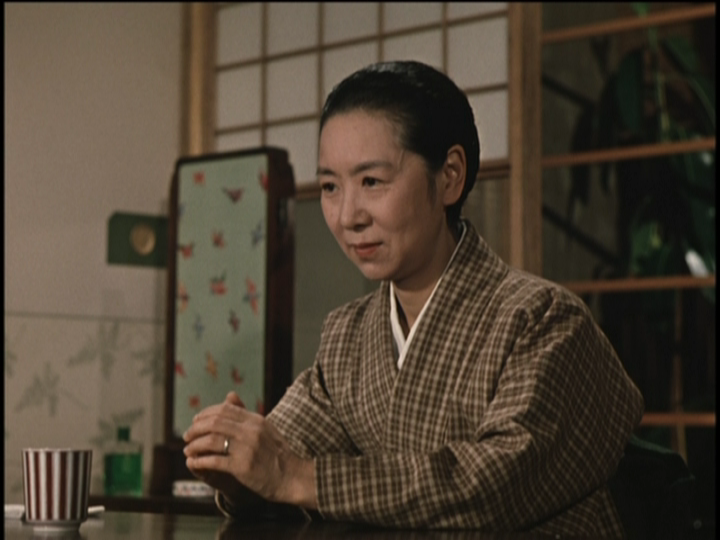 The best performances here are all excellent, but those of Tanaka and Saburi are especially wonderful. Tanaka (appearing for the last time in an Ozu film, almost 30 years after her first film with him) is simply amazing -- as very real, very individualized mother, very unlike her recent iconic mother figures in Mizoguchi's Ugetsu and Sansho. Saburi does an excellent job of displaying his character's split personality -- sometimes affably tolerant and understanding, at other times utterly peremptory and dictatorial. T
The best performances here are all excellent, but those of Tanaka and Saburi are especially wonderful. Tanaka (appearing for the last time in an Ozu film, almost 30 years after her first film with him) is simply amazing -- as very real, very individualized mother, very unlike her recent iconic mother figures in Mizoguchi's Ugetsu and Sansho. Saburi does an excellent job of displaying his character's split personality -- sometimes affably tolerant and understanding, at other times utterly peremptory and dictatorial. T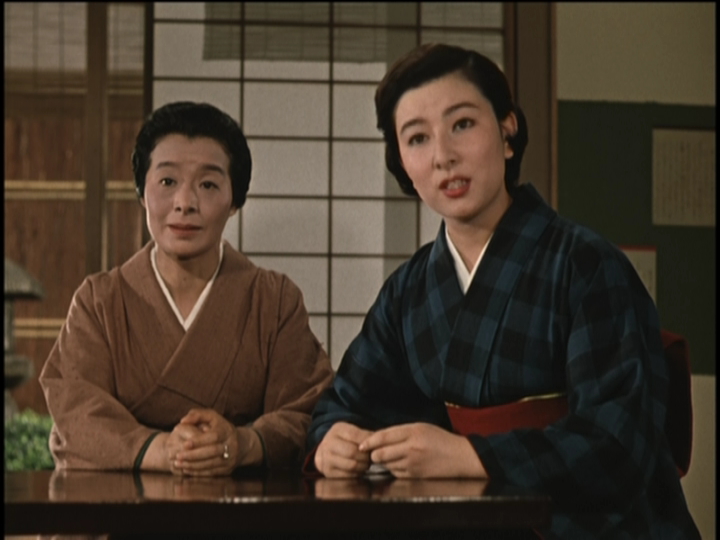 he interaction between the two performers provides a wonderful portrayal of strong and healthy (but far from idealized) marriage. Yamamoto (who was a very popular starlet, known mainly for performing romantic and heroic parts -- on loan from a rival studio) did an excellent job as the daughter's comic friend, vindicating Ozu's decision not to cast her as the daughter. Chieko Naniwa, as her irrepressibly chattering mother, was also quite entertaining.
he interaction between the two performers provides a wonderful portrayal of strong and healthy (but far from idealized) marriage. Yamamoto (who was a very popular starlet, known mainly for performing romantic and heroic parts -- on loan from a rival studio) did an excellent job as the daughter's comic friend, vindicating Ozu's decision not to cast her as the daughter. Chieko Naniwa, as her irrepressibly chattering mother, was also quite entertaining.
 The new Criterion DVD has generally good subtitles (more complete than those on the UK DVD), but is otherwise less well-produced than some of the other DVDs in Eclipse's Late Ozu box set. The colors are considerably more garish than those on Shochiku's DVD and the DVD contains digitization artifacts that don't exist on the Japanese disc (or its subtitled British descendant). I made screen captures of both versions, but am including those from the Japanese DVD as illustrations here. (Maybe I will do a comparison of the two later on).
The new Criterion DVD has generally good subtitles (more complete than those on the UK DVD), but is otherwise less well-produced than some of the other DVDs in Eclipse's Late Ozu box set. The colors are considerably more garish than those on Shochiku's DVD and the DVD contains digitization artifacts that don't exist on the Japanese disc (or its subtitled British descendant). I made screen captures of both versions, but am including those from the Japanese DVD as illustrations here. (Maybe I will do a comparison of the two later on).
http://i9.photobucket.com/albums/a59/mkerpan/ozu/efs02.png
http://i9.photobucket.com/albums/a59/mkerpan/ozu/efs06.png
http://i9.photobucket.com/albums/a59/mkerpan/ozu/efs08.png
http://i9.photobucket.com/albums/a59/mkerpan/ozu/efs09.png
http://i9.photobucket.com/albums/a59/mkerpan/ozu/efs10.png
http://i9.photobucket.com/albums/a59/mkerpan/ozu/efs11.png
http://i9.photobucket.com/albums/a59/mkerpan/ozu/efs16.png
http://i9.photobucket.com/albums/a59/mkerpan/ozu/efs18.png
Ta ga tame ni / Portrait of the Wind / literally For Whose Sake? (Taro Hyugaji, 2005)
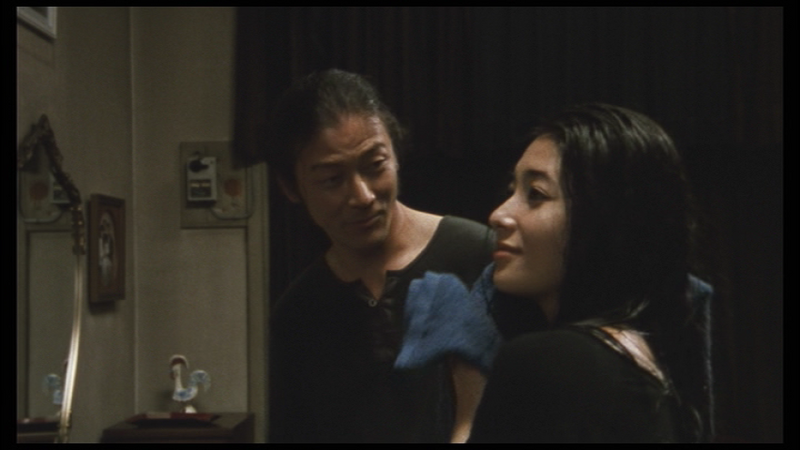 This film, by a first-time director,about coping (or not) with tragedy has a decent premise, but is somewhat ineffectively written and directed. The story centers about a photographer (Tadanobu Asano) who has recently inherited his late father's photography business and a young woman (Erika Oda) looking for a photograph of her long-estranged father.
This film, by a first-time director,about coping (or not) with tragedy has a decent premise, but is somewhat ineffectively written and directed. The story centers about a photographer (Tadanobu Asano) who has recently inherited his late father's photography business and a young woman (Erika Oda) looking for a photograph of her long-estranged father. 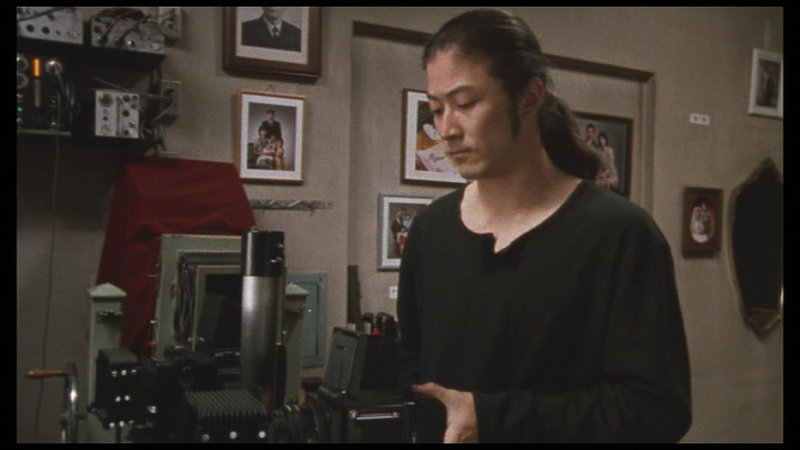 The two fall in love and get married, but only a few months later she is murdered by a juvenile delinquent (for no particular reason). The younger sister of a lifelong buddy, long in love with Asano herself (Chizuru Ikewaki), tries to help him recover from his grief. However, when the killer is released from detention after only a year or so, Asano is torn between his desire to exact the vengeance the law denied him and his late-blooming relationship with Ikewaki.
The two fall in love and get married, but only a few months later she is murdered by a juvenile delinquent (for no particular reason). The younger sister of a lifelong buddy, long in love with Asano herself (Chizuru Ikewaki), tries to help him recover from his grief. However, when the killer is released from detention after only a year or so, Asano is torn between his desire to exact the vengeance the law denied him and his late-blooming relationship with Ikewaki.
 The weighty issues here are poorly thought through and developed -- leaving Asano rather adrift much of the time. Oda does a decent job, but ultimately plays only a fairly small part in the proceedings. By far the strongest performance in the film is that of Chizuru Ikewaki, who seems to be one of those rare performers
The weighty issues here are poorly thought through and developed -- leaving Asano rather adrift much of the time. Oda does a decent job, but ultimately plays only a fairly small part in the proceedings. By far the strongest performance in the film is that of Chizuru Ikewaki, who seems to be one of those rare performers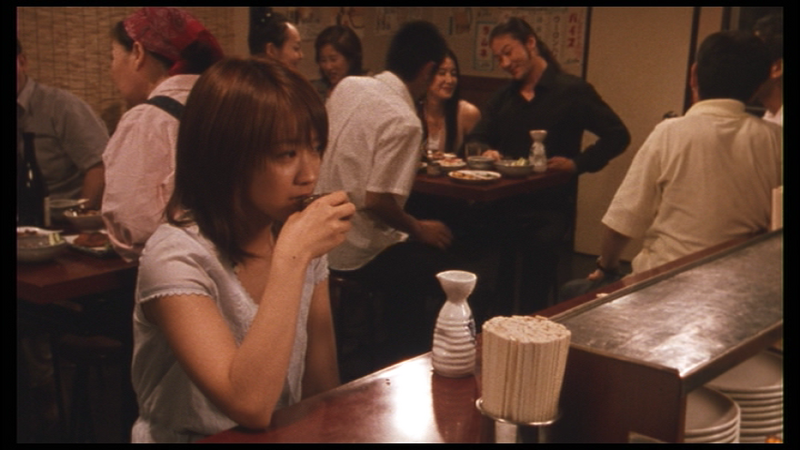 (like Kinuyo Tanaka) able to create something convincing out of cinematic thin air. While Ikewaki is not yet a new Tanaka, Tanaka herself was still only a promising beginner in her early 20s. The cinematography was adequate -- but like the script -- rarely inspired. If only the other elements of the film had risen to Ikewaki's level...
(like Kinuyo Tanaka) able to create something convincing out of cinematic thin air. While Ikewaki is not yet a new Tanaka, Tanaka herself was still only a promising beginner in her early 20s. The cinematography was adequate -- but like the script -- rarely inspired. If only the other elements of the film had risen to Ikewaki's level...
Gedo senki / Tales from Earthsea (Goro Miyazaki, 2006)
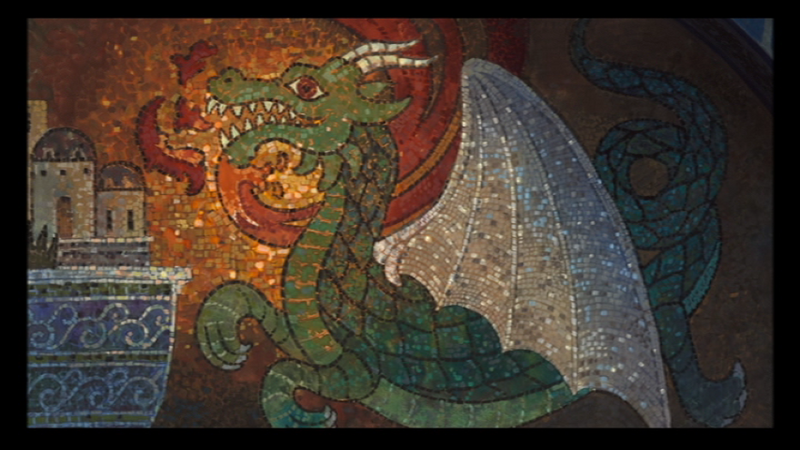 Originally Hayao Miyazaki was supposed to direct this adaptation of Ursula Le Guin's Earthsea series -- but he was preoccupied with Howl's Moving Castle for so long (and thinking of retirement as soon as he finished it), so the studio (and Le Guin)
Originally Hayao Miyazaki was supposed to direct this adaptation of Ursula Le Guin's Earthsea series -- but he was preoccupied with Howl's Moving Castle for so long (and thinking of retirement as soon as he finished it), so the studio (and Le Guin) 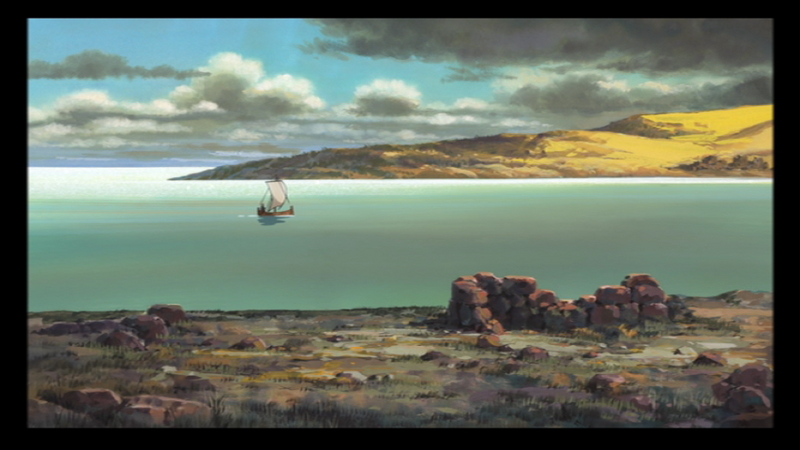 decided to allow the project to go ahead under the direction of Miyazaki's son, Goro (a first-time director) instead. Financially, this was a good decision -- as the film made a huge amount of money at the Japanese box office. Artistically, things are far more questionable. And without doubt, Le Guin was very disappointed by the final result.
decided to allow the project to go ahead under the direction of Miyazaki's son, Goro (a first-time director) instead. Financially, this was a good decision -- as the film made a huge amount of money at the Japanese box office. Artistically, things are far more questionable. And without doubt, Le Guin was very disappointed by the final result.
 The film uses the general plot outline of the third Earthsea book The Farthest Shore -- and mixes in tho this (and misuses) some random elements from the first couple of books and some major background elements from the fourth book Tehanu.
The film uses the general plot outline of the third Earthsea book The Farthest Shore -- and mixes in tho this (and misuses) some random elements from the first couple of books and some major background elements from the fourth book Tehanu. 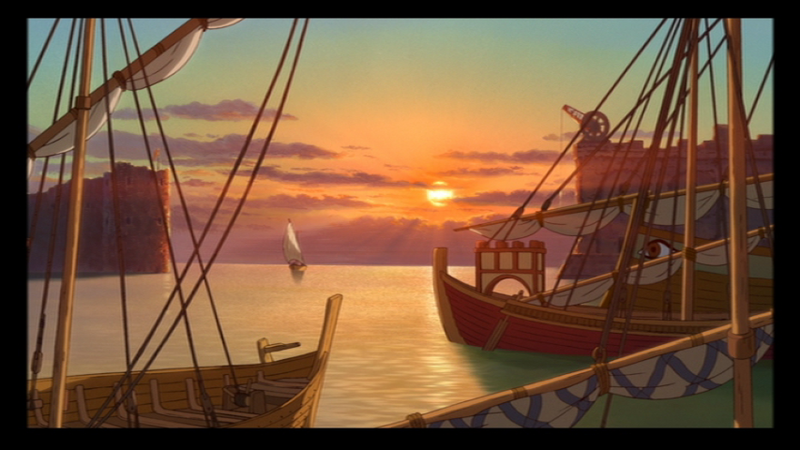 In addition, Goro Miyazaki tossed in character designs and plot elements fro his father's early manga Shuna's Journey -- and borrowed (way too many) motifs and character designs from his father's older movies. On the other hand, this adaptation jettisons almost all the geography and sociology of Le Guin's watery fantasy world.
In addition, Goro Miyazaki tossed in character designs and plot elements fro his father's early manga Shuna's Journey -- and borrowed (way too many) motifs and character designs from his father's older movies. On the other hand, this adaptation jettisons almost all the geography and sociology of Le Guin's watery fantasy world.
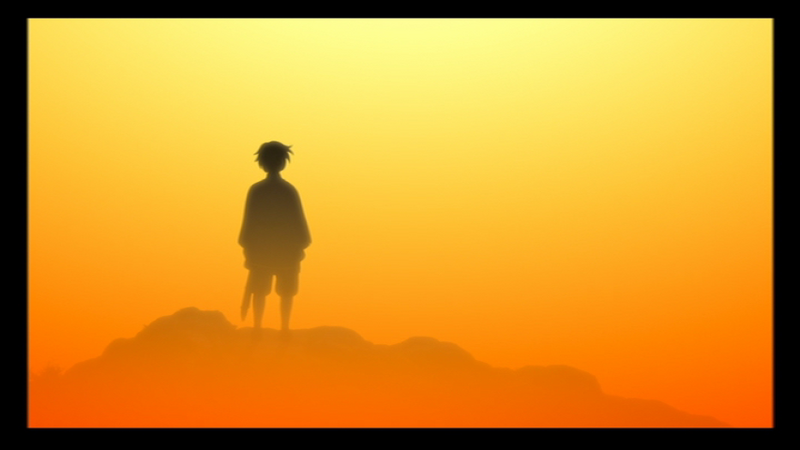 The result is an often good looking, but ultimately derivative pastiche. Ironically, Hayao Miyazaki (who first tried to get permission for an adaptation two decades ago) could have made an excellent straightforward adaptation of The Farthest Shore,
The result is an often good looking, but ultimately derivative pastiche. Ironically, Hayao Miyazaki (who first tried to get permission for an adaptation two decades ago) could have made an excellent straightforward adaptation of The Farthest Shore, 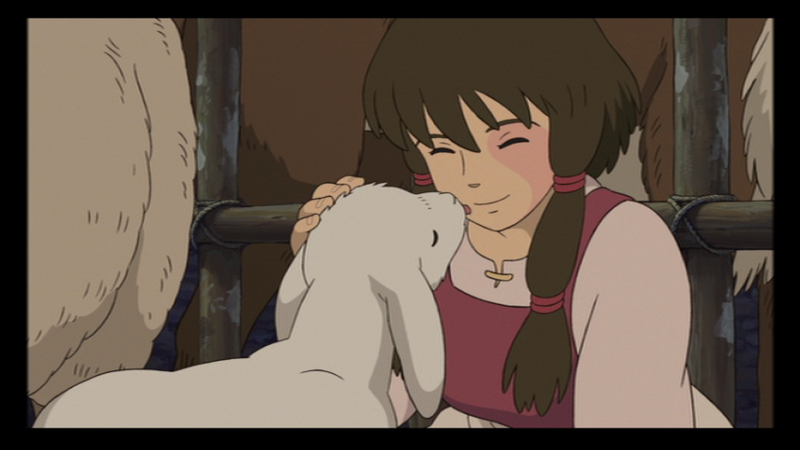 while his colleague Isao Takahata would have found the more pastoral Tehanu (about Arch-mage Ged in retirement) more his kind of material. The idea of mixing (and mashing) the two books together (mainly to concoct a romance for the young hero of the film -- that doesn't exist in the novels) was a poor one.
while his colleague Isao Takahata would have found the more pastoral Tehanu (about Arch-mage Ged in retirement) more his kind of material. The idea of mixing (and mashing) the two books together (mainly to concoct a romance for the young hero of the film -- that doesn't exist in the novels) was a poor one.
 I am not certain what someone who has not read Le Guin's stories or seem Hayao Miyazaki's films would think of this. As one who is a fan of both, I found the film quite disappointing -- all in all, the least good Studio Ghibli film to date. On the other hand, even a sub-par Ghibli film can be expected to be visually beautiful -- and this expectation at least is not disappointed.
I am not certain what someone who has not read Le Guin's stories or seem Hayao Miyazaki's films would think of this. As one who is a fan of both, I found the film quite disappointing -- all in all, the least good Studio Ghibli film to date. On the other hand, even a sub-par Ghibli film can be expected to be visually beautiful -- and this expectation at least is not disappointed. 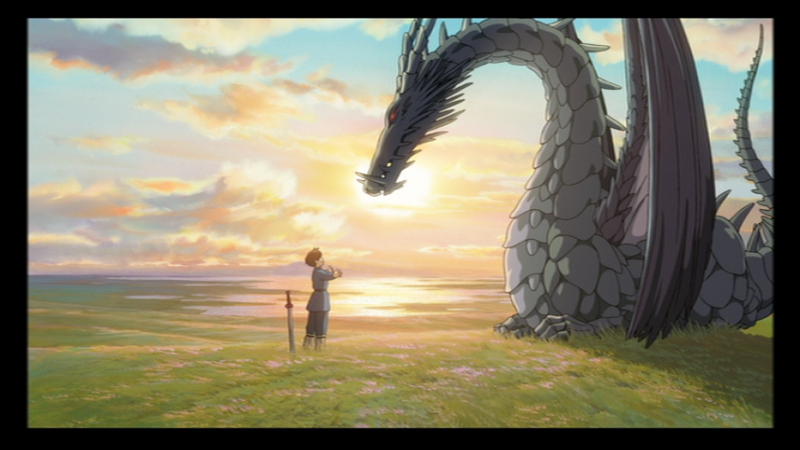 While the character designs are a bit problematic at times, the background designs are utterly gorgeous. Apparently, this film can not be distributed in the United States until 2009, due to licensing issues arising from the US television adaptation.. A subtitled HK DVD should be out soon -- so incorrigble Ghibli fans with multi-region DVD players should be able to satisfy their curiosity without having to pay for the more expensive Japanese release.
While the character designs are a bit problematic at times, the background designs are utterly gorgeous. Apparently, this film can not be distributed in the United States until 2009, due to licensing issues arising from the US television adaptation.. A subtitled HK DVD should be out soon -- so incorrigble Ghibli fans with multi-region DVD players should be able to satisfy their curiosity without having to pay for the more expensive Japanese release.
Rescue Dawn (Werner Herzog, 2006)
 Werner Herzog's 1997 Little Dieter Needs to Fly is one of the most engaging of his (sort of) documentaries. A major attraction of this film was Dieter Dengler himself -- who revisited places associated with his life as a prisoner of war in Laos during the VietNam war. Sadly, Dengler died in 2001, from Lou Gehrig's Disease. Herzog's new film presents Dengler's story of captivity in a dramatized form, with Christian Bale as his stand in.
Werner Herzog's 1997 Little Dieter Needs to Fly is one of the most engaging of his (sort of) documentaries. A major attraction of this film was Dieter Dengler himself -- who revisited places associated with his life as a prisoner of war in Laos during the VietNam war. Sadly, Dengler died in 2001, from Lou Gehrig's Disease. Herzog's new film presents Dengler's story of captivity in a dramatized form, with Christian Bale as his stand in.
It is hard to set aside Dengler himself in the earlier film (which is an indispensable one for anyone interested in Herzog's work). That being said, the new film is very well made. The story is, of course, compelling -- and the performances are quite fine, as is the cinematography of Peter Zeitlinger (who also shot Little Dieter and many other , more recent Herzaog films). Supposedly (according to some critics), the "most commerical" of Herzog's films to date, it is nonetheless a worthy effort, even if it is not a new Aguirre or Stroszek.
Forest Hills Lantern Festival
Every July for the past nine years, Forest Hills Cemetery in Boston has hosted a Latern Festival, inspired by the traditional o-bon ceremony from Japan (also held in July or August, depending on the region). Ideally, such ceremonies should take place next to a moving body of water, so that floating lanterns can glide gently along with the current. Lake Hibiscus at Forest Hills is only a pond, but with even a reasonable amount of breeze, lanterns are blown into the center, making a lovely twilight spectacle. As usual, the placement of lanterns was preceded by teen-aged Japanese dancers, younger and older Chinese dancers, a gospel group and marvelous performance by Samurai Taiko.
 After the crushing rejection of his magnificently bleak Tokyo Twilight, Ozu tried again to present his version of "Father Doesn't Know Best" -- this time as a comedy. While Ineko Arima once again appeared as a daughter at odds with her father, Shin Saburi was given the role of the father. So long as Saburi is talking about other peoples' children, he supports the right of young women to make their own decisions.
After the crushing rejection of his magnificently bleak Tokyo Twilight, Ozu tried again to present his version of "Father Doesn't Know Best" -- this time as a comedy. While Ineko Arima once again appeared as a daughter at odds with her father, Shin Saburi was given the role of the father. So long as Saburi is talking about other peoples' children, he supports the right of young women to make their own decisions.  In particular, he tries to reconcile a friend (chishu Ru) with a daughter (Yoshiko Kuga) who has moved in with her boyfriend without the benefit of marriage. But when his own eldest daughter picks a husband without getting his prior approval, Saburi goes ballistic. Luckily for Arima, in this film she has a supportive mother (Kinuyo Tanaka) and an ingenious friend (Fujiko Yamamoto), who support her cause.
In particular, he tries to reconcile a friend (chishu Ru) with a daughter (Yoshiko Kuga) who has moved in with her boyfriend without the benefit of marriage. But when his own eldest daughter picks a husband without getting his prior approval, Saburi goes ballistic. Luckily for Arima, in this film she has a supportive mother (Kinuyo Tanaka) and an ingenious friend (Fujiko Yamamoto), who support her cause. The best performances here are all excellent, but those of Tanaka and Saburi are especially wonderful. Tanaka (appearing for the last time in an Ozu film, almost 30 years after her first film with him) is simply amazing -- as very real, very individualized mother, very unlike her recent iconic mother figures in Mizoguchi's Ugetsu and Sansho. Saburi does an excellent job of displaying his character's split personality -- sometimes affably tolerant and understanding, at other times utterly peremptory and dictatorial. T
The best performances here are all excellent, but those of Tanaka and Saburi are especially wonderful. Tanaka (appearing for the last time in an Ozu film, almost 30 years after her first film with him) is simply amazing -- as very real, very individualized mother, very unlike her recent iconic mother figures in Mizoguchi's Ugetsu and Sansho. Saburi does an excellent job of displaying his character's split personality -- sometimes affably tolerant and understanding, at other times utterly peremptory and dictatorial. T he interaction between the two performers provides a wonderful portrayal of strong and healthy (but far from idealized) marriage. Yamamoto (who was a very popular starlet, known mainly for performing romantic and heroic parts -- on loan from a rival studio) did an excellent job as the daughter's comic friend, vindicating Ozu's decision not to cast her as the daughter. Chieko Naniwa, as her irrepressibly chattering mother, was also quite entertaining.
he interaction between the two performers provides a wonderful portrayal of strong and healthy (but far from idealized) marriage. Yamamoto (who was a very popular starlet, known mainly for performing romantic and heroic parts -- on loan from a rival studio) did an excellent job as the daughter's comic friend, vindicating Ozu's decision not to cast her as the daughter. Chieko Naniwa, as her irrepressibly chattering mother, was also quite entertaining. The new Criterion DVD has generally good subtitles (more complete than those on the UK DVD), but is otherwise less well-produced than some of the other DVDs in Eclipse's Late Ozu box set. The colors are considerably more garish than those on Shochiku's DVD and the DVD contains digitization artifacts that don't exist on the Japanese disc (or its subtitled British descendant). I made screen captures of both versions, but am including those from the Japanese DVD as illustrations here. (Maybe I will do a comparison of the two later on).
The new Criterion DVD has generally good subtitles (more complete than those on the UK DVD), but is otherwise less well-produced than some of the other DVDs in Eclipse's Late Ozu box set. The colors are considerably more garish than those on Shochiku's DVD and the DVD contains digitization artifacts that don't exist on the Japanese disc (or its subtitled British descendant). I made screen captures of both versions, but am including those from the Japanese DVD as illustrations here. (Maybe I will do a comparison of the two later on).http://i9.photobucket.com/albums/a59/mkerpan/ozu/efs02.png
http://i9.photobucket.com/albums/a59/mkerpan/ozu/efs06.png
http://i9.photobucket.com/albums/a59/mkerpan/ozu/efs08.png
http://i9.photobucket.com/albums/a59/mkerpan/ozu/efs09.png
http://i9.photobucket.com/albums/a59/mkerpan/ozu/efs10.png
http://i9.photobucket.com/albums/a59/mkerpan/ozu/efs11.png
http://i9.photobucket.com/albums/a59/mkerpan/ozu/efs16.png
http://i9.photobucket.com/albums/a59/mkerpan/ozu/efs18.png
Ta ga tame ni / Portrait of the Wind / literally For Whose Sake? (Taro Hyugaji, 2005)
 This film, by a first-time director,about coping (or not) with tragedy has a decent premise, but is somewhat ineffectively written and directed. The story centers about a photographer (Tadanobu Asano) who has recently inherited his late father's photography business and a young woman (Erika Oda) looking for a photograph of her long-estranged father.
This film, by a first-time director,about coping (or not) with tragedy has a decent premise, but is somewhat ineffectively written and directed. The story centers about a photographer (Tadanobu Asano) who has recently inherited his late father's photography business and a young woman (Erika Oda) looking for a photograph of her long-estranged father.  The two fall in love and get married, but only a few months later she is murdered by a juvenile delinquent (for no particular reason). The younger sister of a lifelong buddy, long in love with Asano herself (Chizuru Ikewaki), tries to help him recover from his grief. However, when the killer is released from detention after only a year or so, Asano is torn between his desire to exact the vengeance the law denied him and his late-blooming relationship with Ikewaki.
The two fall in love and get married, but only a few months later she is murdered by a juvenile delinquent (for no particular reason). The younger sister of a lifelong buddy, long in love with Asano herself (Chizuru Ikewaki), tries to help him recover from his grief. However, when the killer is released from detention after only a year or so, Asano is torn between his desire to exact the vengeance the law denied him and his late-blooming relationship with Ikewaki. The weighty issues here are poorly thought through and developed -- leaving Asano rather adrift much of the time. Oda does a decent job, but ultimately plays only a fairly small part in the proceedings. By far the strongest performance in the film is that of Chizuru Ikewaki, who seems to be one of those rare performers
The weighty issues here are poorly thought through and developed -- leaving Asano rather adrift much of the time. Oda does a decent job, but ultimately plays only a fairly small part in the proceedings. By far the strongest performance in the film is that of Chizuru Ikewaki, who seems to be one of those rare performers (like Kinuyo Tanaka) able to create something convincing out of cinematic thin air. While Ikewaki is not yet a new Tanaka, Tanaka herself was still only a promising beginner in her early 20s. The cinematography was adequate -- but like the script -- rarely inspired. If only the other elements of the film had risen to Ikewaki's level...
(like Kinuyo Tanaka) able to create something convincing out of cinematic thin air. While Ikewaki is not yet a new Tanaka, Tanaka herself was still only a promising beginner in her early 20s. The cinematography was adequate -- but like the script -- rarely inspired. If only the other elements of the film had risen to Ikewaki's level...Gedo senki / Tales from Earthsea (Goro Miyazaki, 2006)
 Originally Hayao Miyazaki was supposed to direct this adaptation of Ursula Le Guin's Earthsea series -- but he was preoccupied with Howl's Moving Castle for so long (and thinking of retirement as soon as he finished it), so the studio (and Le Guin)
Originally Hayao Miyazaki was supposed to direct this adaptation of Ursula Le Guin's Earthsea series -- but he was preoccupied with Howl's Moving Castle for so long (and thinking of retirement as soon as he finished it), so the studio (and Le Guin)  decided to allow the project to go ahead under the direction of Miyazaki's son, Goro (a first-time director) instead. Financially, this was a good decision -- as the film made a huge amount of money at the Japanese box office. Artistically, things are far more questionable. And without doubt, Le Guin was very disappointed by the final result.
decided to allow the project to go ahead under the direction of Miyazaki's son, Goro (a first-time director) instead. Financially, this was a good decision -- as the film made a huge amount of money at the Japanese box office. Artistically, things are far more questionable. And without doubt, Le Guin was very disappointed by the final result. The film uses the general plot outline of the third Earthsea book The Farthest Shore -- and mixes in tho this (and misuses) some random elements from the first couple of books and some major background elements from the fourth book Tehanu.
The film uses the general plot outline of the third Earthsea book The Farthest Shore -- and mixes in tho this (and misuses) some random elements from the first couple of books and some major background elements from the fourth book Tehanu.  In addition, Goro Miyazaki tossed in character designs and plot elements fro his father's early manga Shuna's Journey -- and borrowed (way too many) motifs and character designs from his father's older movies. On the other hand, this adaptation jettisons almost all the geography and sociology of Le Guin's watery fantasy world.
In addition, Goro Miyazaki tossed in character designs and plot elements fro his father's early manga Shuna's Journey -- and borrowed (way too many) motifs and character designs from his father's older movies. On the other hand, this adaptation jettisons almost all the geography and sociology of Le Guin's watery fantasy world. The result is an often good looking, but ultimately derivative pastiche. Ironically, Hayao Miyazaki (who first tried to get permission for an adaptation two decades ago) could have made an excellent straightforward adaptation of The Farthest Shore,
The result is an often good looking, but ultimately derivative pastiche. Ironically, Hayao Miyazaki (who first tried to get permission for an adaptation two decades ago) could have made an excellent straightforward adaptation of The Farthest Shore,  while his colleague Isao Takahata would have found the more pastoral Tehanu (about Arch-mage Ged in retirement) more his kind of material. The idea of mixing (and mashing) the two books together (mainly to concoct a romance for the young hero of the film -- that doesn't exist in the novels) was a poor one.
while his colleague Isao Takahata would have found the more pastoral Tehanu (about Arch-mage Ged in retirement) more his kind of material. The idea of mixing (and mashing) the two books together (mainly to concoct a romance for the young hero of the film -- that doesn't exist in the novels) was a poor one. I am not certain what someone who has not read Le Guin's stories or seem Hayao Miyazaki's films would think of this. As one who is a fan of both, I found the film quite disappointing -- all in all, the least good Studio Ghibli film to date. On the other hand, even a sub-par Ghibli film can be expected to be visually beautiful -- and this expectation at least is not disappointed.
I am not certain what someone who has not read Le Guin's stories or seem Hayao Miyazaki's films would think of this. As one who is a fan of both, I found the film quite disappointing -- all in all, the least good Studio Ghibli film to date. On the other hand, even a sub-par Ghibli film can be expected to be visually beautiful -- and this expectation at least is not disappointed.  While the character designs are a bit problematic at times, the background designs are utterly gorgeous. Apparently, this film can not be distributed in the United States until 2009, due to licensing issues arising from the US television adaptation.. A subtitled HK DVD should be out soon -- so incorrigble Ghibli fans with multi-region DVD players should be able to satisfy their curiosity without having to pay for the more expensive Japanese release.
While the character designs are a bit problematic at times, the background designs are utterly gorgeous. Apparently, this film can not be distributed in the United States until 2009, due to licensing issues arising from the US television adaptation.. A subtitled HK DVD should be out soon -- so incorrigble Ghibli fans with multi-region DVD players should be able to satisfy their curiosity without having to pay for the more expensive Japanese release.Rescue Dawn (Werner Herzog, 2006)
 Werner Herzog's 1997 Little Dieter Needs to Fly is one of the most engaging of his (sort of) documentaries. A major attraction of this film was Dieter Dengler himself -- who revisited places associated with his life as a prisoner of war in Laos during the VietNam war. Sadly, Dengler died in 2001, from Lou Gehrig's Disease. Herzog's new film presents Dengler's story of captivity in a dramatized form, with Christian Bale as his stand in.
Werner Herzog's 1997 Little Dieter Needs to Fly is one of the most engaging of his (sort of) documentaries. A major attraction of this film was Dieter Dengler himself -- who revisited places associated with his life as a prisoner of war in Laos during the VietNam war. Sadly, Dengler died in 2001, from Lou Gehrig's Disease. Herzog's new film presents Dengler's story of captivity in a dramatized form, with Christian Bale as his stand in.It is hard to set aside Dengler himself in the earlier film (which is an indispensable one for anyone interested in Herzog's work). That being said, the new film is very well made. The story is, of course, compelling -- and the performances are quite fine, as is the cinematography of Peter Zeitlinger (who also shot Little Dieter and many other , more recent Herzaog films). Supposedly (according to some critics), the "most commerical" of Herzog's films to date, it is nonetheless a worthy effort, even if it is not a new Aguirre or Stroszek.
Forest Hills Lantern Festival
Every July for the past nine years, Forest Hills Cemetery in Boston has hosted a Latern Festival, inspired by the traditional o-bon ceremony from Japan (also held in July or August, depending on the region). Ideally, such ceremonies should take place next to a moving body of water, so that floating lanterns can glide gently along with the current. Lake Hibiscus at Forest Hills is only a pond, but with even a reasonable amount of breeze, lanterns are blown into the center, making a lovely twilight spectacle. As usual, the placement of lanterns was preceded by teen-aged Japanese dancers, younger and older Chinese dancers, a gospel group and marvelous performance by Samurai Taiko.
Comments
As an immense Ozu fan one thing I've long wondered is exactly how well the films did financially, how popular they were, how they were perceived (by audiences), what their relative budgets were compared to other films, etc.
Most of Ozu's films supposedly either broke even or did moderately well. He was sort of a studio "loss leader" -- whose work was supposed to burnish Shochiku's reputation. Only a few of his films were huge financial successes. At the same time, few of his films failed to do reasonably well. The exceptions are those where Ozu confronted his audience, asking them (fairly directly) to reflect on their own responsibilities as citizens. Other examples of relatively "unsuccessful" Ozu films -- Record of a Tenement Gentleman and Hen in the Wind.
As I recall, Lady and the Beard was apparently a film that did especially well at the box office. ;~}